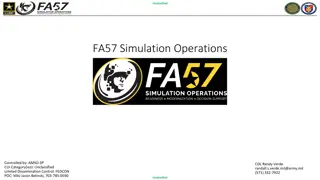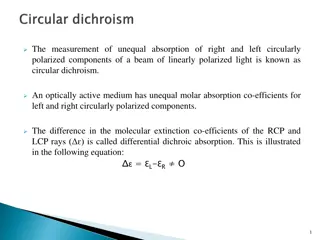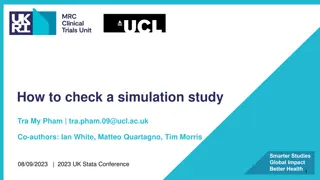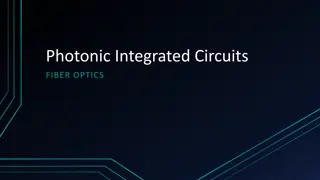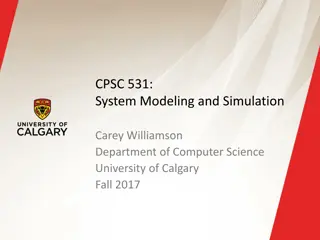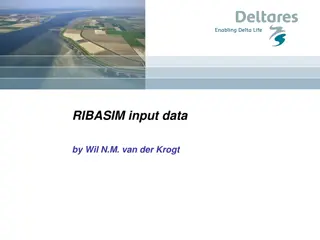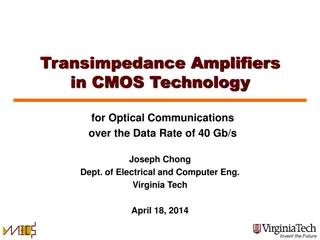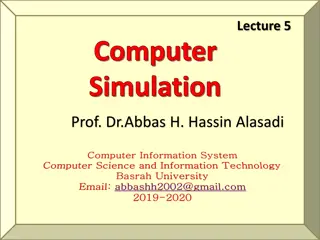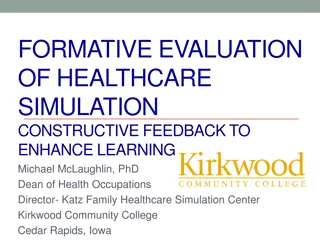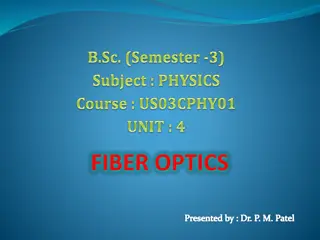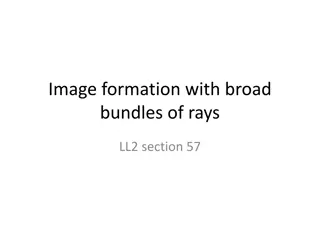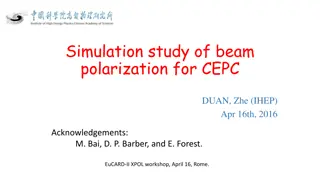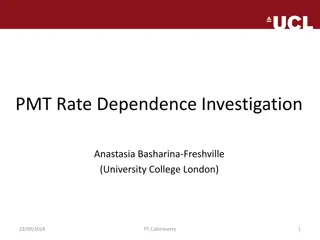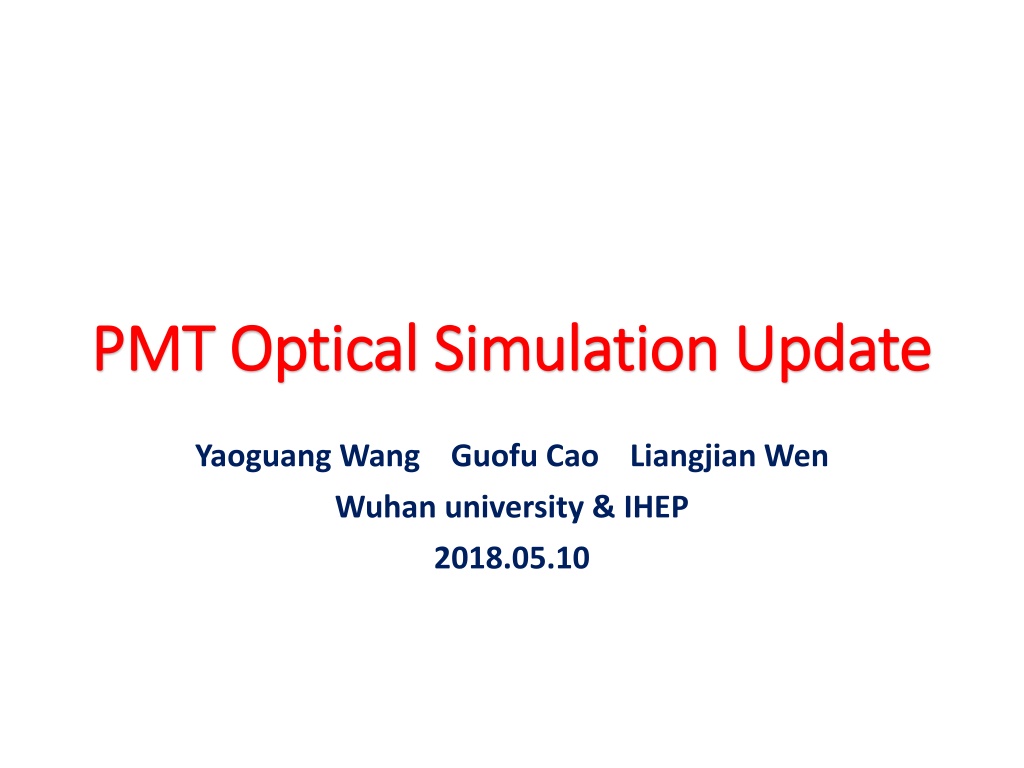
Advanced PMT Optical Simulation Update and Comparison
Explore the latest developments in PMT optical simulation, including an introduction of a new model and comparison with existing models. Learn about the simulation procedures, photon interactions, angle responses, and simulation methods involved in optimizing PMT performance. Stay informed on the future plans and enhancements in PMT optical technology.
Uploaded on | 1 Views
Download Presentation

Please find below an Image/Link to download the presentation.
The content on the website is provided AS IS for your information and personal use only. It may not be sold, licensed, or shared on other websites without obtaining consent from the author. If you encounter any issues during the download, it is possible that the publisher has removed the file from their server.
You are allowed to download the files provided on this website for personal or commercial use, subject to the condition that they are used lawfully. All files are the property of their respective owners.
The content on the website is provided AS IS for your information and personal use only. It may not be sold, licensed, or shared on other websites without obtaining consent from the author.
E N D
Presentation Transcript
PMT Optical Simulation Update PMT Optical Simulation Update Yaoguang Wang Guofu Cao Liangjian Wen Wuhan university & IHEP 2018.05.10
Outline Outline Comparison of two PMT models Introduction of the new model Input parameters needed Usage of the new model in offline software Future plan
Current PMT optical model Current PMT optical model Simulation procedure Optical photon goes from water to glass, reflection and refraction happens here Photon reaches the photocathode, which is an optical surface between glass and vacuum. The reflectivity of the surface is zero so that the photon will be detected or absorbed Depending on Q.E., the photon is detected or absorbed If the photon is detected, the C.E. is applied in sensitive detector If it is collected, a hit is generated Ref: ihepjuno-doc-469-v1
The new model The new model Photons hitting on photocathode may undergo three processes: Absorbed by photocathode, with probability ?(?,?) If a photon is absorbed, a p.e. will be generated, the probability of it to escape from photocathode is related to a escape factor: ? ? ?? ?,? = ? ?,? ?(?) Reflected by photocathode, with probability ?(?,?) Transmitted into the PMT, with probability ? ?,? Photons may be reflected by Al film on bottom surface, and absorbed by photocathode again Ref: NIMA 539(2005)217-235, Doc1595, Doc1811 air(water) ?,?,? can be calculated with Snell s Law and Fresnel equations. Photocathode have complex refraction index ? = ? + ?? glass photocathode PMT vacuum Multi-layered medium system
Angle response Angle response Total internal reflection between photocathode and PMT vacuum leads to different angle responses if we put PMT in water Maximum of ? distribution is around 40 angle response may not be negligible The old model gives nearly the same result in these two conditions wavelength@410nm Critical angle ? ? distribution in JUNO detector
Simulation method (1) Simulation method (1) Photons hitting on PMT surface may undergo three processes: Reflection Absorption, photoelectron may escape from photocathode, and collected by dynode or mcp Transmission DE can be denoted as: ??(?,?) = ?(?,?) ?(?) ??(?) Reflection of Al film is not considered here absorption collection efficiency escape probability Absorption can be given by simulation, ? ?? can be got from scanning station measurement. Simulation based on Geant4 6
Simulation method (2) Simulation method (2) DE measured in scanning station is contributed by different points due to reflection: ? ? ?? = ?? ?? ???= ?? ?? ?=1 ?=1 From scanning station data, we can solve the equation set to get ?: ??1 ??2 ??? ?1 ?2 ?? ?11 ??1 ?1? ??? From experiment = From simulation Putting the ? map solved into simulation enables us to simulate the Al film reflection Note: escape probability ? is assumed the same for transmission photocathode and reflection photocathode 7
Problem of method 2 Problem of method 2 DE curve from simulation is not continuous caused by reflection, more data are needed to constrain reflection contribution. Method 1 is now applied in simulation, more study on method 2 will be done Blue: input DE curve Red: DE curve from simulation 8
Input parameters Input parameters Ref: NIMA 539(2005)217-235 Refraction index and thickness of photocathode (necessary) Measurement of PMT reflectivity vs incident angle will be done to constrain them If ?,?,? of photocathode has been measured, the absorption of it can be determined immediately QE and CE (Option 1) We can get escape factor with QE and absorption refraction index of photocathode ? =?? ? DE (Option 2) DE map has been measured in scanning station, with DE and absorption, we can get the ? ?????????, ?? ? ? = ? ?? = In this case, we do not need the CE curve
Offline software update Offline software update Geometry: $PMTSIMROOT MCP-PMT: NNVTMCPPMTManager MCPNewModel Hamamatsu: HamamatsuR12860PMTManager R12860NewModel MCP-PMT Hamamatsu Physics: $PHYSISIMROOT New class for film interference effect calculation: DsG4OpticalMembrane Interference effect added into optical boundary process: DsG4OpBoundaryProcess Options: $DETSIMOPTION/src/LSExpDetectorConstruction.cc Hamamatsu: R12860NewModel Hamamatsu+Mask: R12860MaskNewModel MCP-PMT: MCPNewModel MCP-PMT+Mask: MCPMaskNewModel
Usage of the new model Usage of the new model Simulation with MCP-PMT + Mask python tut_detsim.py --evtmax 100 --pmt20inch-name MCPMaskNewModel hepevt --exe IBD --volume pTarget The new model has not been submitted to svn, more check will be done Anyone interested in it can source /junofs/users/wangyg/NewOffline/bashrc
Conclusion Conclusion and and furture furture plan plan The new PMT optical model gives a more accurate angle response, especially when put PMT in water The new model has been added to JUNO offline software, more check will be done PMT reflectivity measurement is in the plan to get the parameters of photocathode



